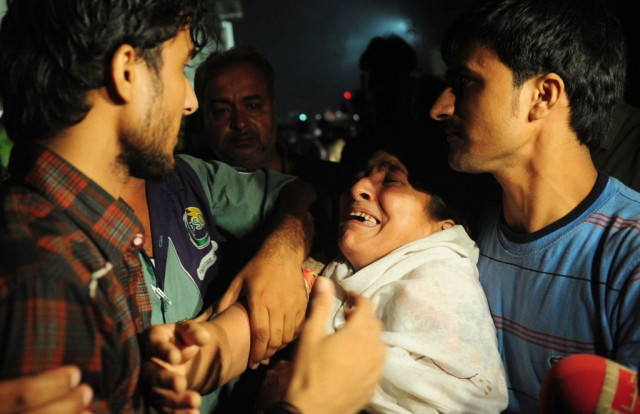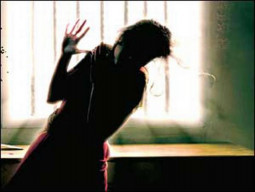
Anxious relatives could only watch in despair as flames swallowed a garment factory building in Karachi on Wednesday.
With heavy hearts, desperate family members ran to the scene and scuffled with police, which had its hands full preventing panicked relatives from running into the blazing factory, which could collapse at any time.
“They are dying. Oh, media people why are you silent, please, please do something,” shouted another at the sea of photographers, cameramen and reporters covering the accident.
Behind the flames and smoke, a dead body was seen stuck to a window, as if the victim had been trying to jump from the second floor, but just didn’t make it in time, said a news agency photographer.
“I can’t find my sister. I searched two hospitals but I could not find her. When will they bring out the bodies?” screamed a woman in agony outside Ali Enterprises, the ill-fated garment factory in Baldia town, where 1,200 registered employees made ready-to-wear clothing dispatched across the country and exported abroad, including to Britain.
It remains unclear how the inferno began in the worst ever industrial fire in the history of Pakistan. Many workers burnt to death, others suffocated or succumbed to the effects of the fire en route to hospital, while dozens jumped from the upper storeys into the street as others stood on the roof, hoping to be rescued.
Another burqa-clad woman, sobbed for her 28-year-old uncle. “He was supposed to come early from work that night because we were all going to my sister’s wedding ceremony. The news on the television shook us and we tried calling his cell phone but it was off,” she sobbed.
Near the factory, a relief camp was set up by a political party, where relatives gathered to inquire about their missing family members.
Irfan, whose sister-in-law Saira worked in the stitching department, said he had been searching for her since last night but hadn’t been successful in finding her. “We are stuck in the middle. If she is alive, please let us know. If she is dead, give us her body,” said a flustered Irfan.
Although the fire had been extinguished completely on Wednesday, the factory was still smouldering from the inside, rescue workers adding that workers in the factory had been burnt alive in temperatures rising up to 200 Celsius.
At the Civil Hospital hundreds of grieving relatives desperately searched for mothers, fathers, brothers, sisters, sons and daughters among the dozens of badly mutilated bodies, burnt beyond recognition.
Talking to The Express Tribune, police surgeon Kamal Sheikh said that while some victims had died of suffocation, a majority had died from severe fire burns, adding that fifty body samples had already been sent for DNA tests.
Mohammad Yaqoob, who should have been working on Tuesday but called in sick, was unable to find his younger brother, Mehtab Ali, among those who perished. “I have seen many bodies but could not identify any of them. They are badly charred. You need strong nerves to see all of them, which I don’t have,” he said, wiping tears from his eyes.
Emergency wards and morgues in the city’s two other major hospitals were also crowded with the people, crying and beating their chests. Some of them had children with them – some shocked, the rest weeping.
“I have come here to search for my sister,” said a sobbing Mohammad Ashraf, adding that she only earned so her family could survive.
“We have been searching hospitals frantically, but no one says anything to us,” said Shaukat, who had driven from Hyderabad to find his son and son-in-law at Civil Hospital morgue. “The government has machines to demolish katchi abadis, but they don’t have machines to rescue workers. We were poor that’s why our people died like this.”
At the time of incident, there were around 700 people at the factory. Around 60 to 70 women and six to eight children between the ages of 15-16 were reportedly employed at the factory, where most workers belonged to the lower-middle class. (Additional input from AFP)
Published in The Express Tribune, September 13th, 2012.








1726054615-0/OpenAI-(2)1726054615-0-270x192.webp)









COMMENTS
Comments are moderated and generally will be posted if they are on-topic and not abusive.
For more information, please see our Comments FAQ